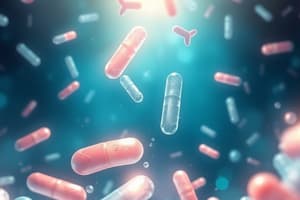Podcast
Questions and Answers
What is the year when Paul Ehrlich worked on developing a synthetic chemical effective against infection-causing cells only?
What is the year when Paul Ehrlich worked on developing a synthetic chemical effective against infection-causing cells only?
What is the primary mechanism of action of sulfonamides?
What is the primary mechanism of action of sulfonamides?
Which of the following is NOT a mechanism of action of anti-infective agents?
Which of the following is NOT a mechanism of action of anti-infective agents?
What is the title of the book referenced in the lesson?
What is the title of the book referenced in the lesson?
Signup and view all the answers
What is the name of the scientist who discovered penicillin in a mold sample?
What is the name of the scientist who discovered penicillin in a mold sample?
Signup and view all the answers
What is the goal of anti-infective therapy?
What is the goal of anti-infective therapy?
Signup and view all the answers
What is the duration of the lesson review/preview or hook activity?
What is the duration of the lesson review/preview or hook activity?
Signup and view all the answers
What type of anti-infectives are effective against only a few microorganisms with a specific metabolic pathway or enzyme?
What type of anti-infectives are effective against only a few microorganisms with a specific metabolic pathway or enzyme?
Signup and view all the answers
What is the characteristic of aminoglycosides?
What is the characteristic of aminoglycosides?
Signup and view all the answers
What is the mechanism of action of cephalosporins?
What is the mechanism of action of cephalosporins?
Signup and view all the answers
What is the characteristic of fluoroquinolones?
What is the characteristic of fluoroquinolones?
Signup and view all the answers
What is the problem with treating infections in immunosuppressed patients?
What is the problem with treating infections in immunosuppressed patients?
Signup and view all the answers




